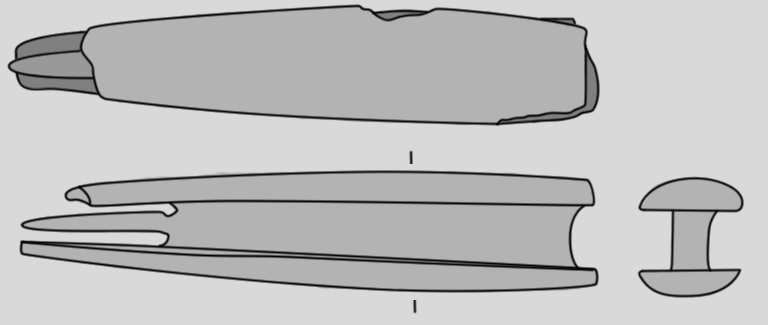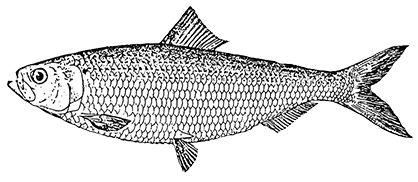Note: This class was based in a large part around my earlier research. While there is a few new things in here, you might find some of the details repetitive.
A PDF of the class handout is available here.
About Hedeby (or Haithabu)
The Viking trading town of Hedeby (Old Norse: Heiðabýr) flourished between the 8th and 11th century and was an important trading settlement at the southern end of the Jutland Peninsular between modern-day Denmark and Germany.

The settlement developed as a trading centre at the head of a narrow, navigable inlet known as the Schlei, which connects to the Baltic Sea. Hedeby was the second largest Nordic town during the Viking Age, after Uppåkra in present-day southern Sweden.
Hedeby was abandoned after its destruction in 1066 and was rediscovered in the late 19th century, with excavations commencing in 1900.
Fishing Methods
Only a relatively small amount of the estimated quanitity of equipment used in fishing has been recovered. This is due to the fact that by its nature, fishing equipment is typically lost underwater, where it is embedded in the mushy sediment.
It’s believed that fishing was usually carried out in dug-out canoes, of which two have been recovered, and by small boats, which appear to be in a number of small burrows in the find. Research into the type and size of these seemingly clinker built boats is not yet complete.
Coarse nets made of three-stranded bast cords – made with a special weaving technique – would not have been suitable for use underwater. However, to what extent they were used in special traps or rough fish traps – comparable to the “herring fences” erected in the Schlei at later times – would just be speculation.
Spearfishing and angling was known to have been carried out to some extent.
The use of ice fishing was also very likely. After a period of frost, the Schlei offers good conditions for this. Nets can be pushed under the ice’s surface (in a method also traditionally practiced by the Inuit), and individuals could also fish through holes in the ice.
Nets
In addition to objects that can be used as floaters or sinkers for gillnets, there is a small net needle hinting at the presence of fine nets.

The Production of Nets
There doesn’t seem to be a completely uniform or standardised size of method for creating nets. The range of finds varies from fine two-ply strings (diameter 4-5 mm), to three-, four- and six-ply ropes (diameter 6-70 mm) to a twine twisted together from twelve smaller fibre ropes (diameter 100 mm). There are numerous methods of knotting and spliced strands, including tarred knots, recorded.
Excavation layers have regularly shown results in all areas of scraps and ropes, for a total of 291 objects. Most of the objects were designated as oak bast (247), others as linden (38) and willow bast (3). In addition to this, cord and rope made of blades of grass, split branches and straw have also been recovered.
The tools and equipment required for local production are particularly scarce, with the netting needle being one of the only recovered examples. A flax beater was also recovered. It could be argued that the large amount of rope recovered is proof of local production, however the ships themselves would require a significant amount of rope to operate.
It has been speculated that the considerable demand could not have been covered without importation from surrounding areas.
The large quantities of bark material required for production likely led to the destruction of all nearby resources. Moreover, the tedious manufacturing process – comparable in time to the spinning of wool and flax – would have required significant man-hours.
The process ranged from debarking the straight young wood, to separating the paper-thin fibres. The dried bast was then put together between the fingers or on the knuckle and rolled into a string – comparable to the thread during spinning. Strands of varying thickness had to be spun around each other in the subsequent roping, so that elastic and tear-resistant cordage was created.
One unique example of a coarse-meshed net was recovered, which was made of 3-ply bast string of about 6 mm in diameter. When the net was stretched, the holes were a largely uniform 9 cm; possibly an indication that a tool called a meschenholz (essentially a piece of dowel used for spacing the joins of a net) was used during production.

The feature of this net that got it a lot of notice was that it was created by placing two 3-ply strings at equal distances from each other, using one of the strands to wrap around the second string, and then returning and continuing in its original string. This method, referred to as the “Haithabu technique,” gave the material strength by bonding the strings together.
It’s thought that the use of such nets for traditional net fishing can be excluded; instead, they were likely used for trapping nets, hunting, or transportation.
If used in transportation, their purpose may have been used for storing goods and securing them for sea travel.
This may be a cool alternative to having 20 6-board chests around the campsite or less period baskets, especially for storing bedding and soft kit at site.
Net Floats and Sinkers

While the “Haithabu technique” likely wasn’t used for fishing, there is significant evidence that nets were used for fishing.
Sinkers made of soapstone and other heavy materials have been found in significant numbers at Hedeby.
One really notable object is a sinker made with a stone held by birch bark in a hoop of split rod.

Floats seemed to primarily be made from rolled birch bark. It is believed that these rolled floats spanned the length of the top of the fishing net, holding it upright in the water, while the sinkers held the bottom of the net to the harbour floor.
Spears
Spearing of fish wasn’t uncommon; prongs of fish spears or forks prove this. It has been speculated that, in addition to the pronged spears, spears may have been made from sharpened branches.

The spear prongs that we do have were predominantly salvaged from the harbour.
Also found were specially shaped iron prongs, with a sharpness in the bow-shaped area. They are referred to as Aalstecher (English: eel spear).
It’s believed that two such arms were mounted on a pole – with this device, eels were skewered while hibernating in the mud during winter.

While not specifically from Hedeby, the below well-preserved 3-pronged fishing spear from 6th Century Norway provides a good visual of how the prongs would have been mounted to a spear.

Angling
Angling was carried out in Viking Age Hedeby, as many finds of hooks in the style used for angling suggest.

It’s believed that fishermen would paddle out into the harbor in small canoes and drop lines over the side.
The hooks themselves would be recognisable to a modern fisherman – their function of a loop in one end to feed a line through, and a pointed section to feed bait on and to hook the fish has not changed much in the last 1000 years.
Distribution of Fish
Below are the most notable fish species proven to have existed in large numbers, in the harbour at Hedeby. From a living history perspective, it would be fantastic to try and base a menu around these species, using their distribution (pie chart below) as a loose guide for how much of each species to incorporate.
Saltwater Fish
- Herring
- Garfish
- Cod
- Flatfish (Flounder)
Freshwater Fish
- Pike
- Carp (Common Roach)
- Perch
- Zander (Pike-Perch)
Migratory Fish
- Whitefish
- Trout
- Eel
As these fish were available, we have a better idea of what is likely to have been consumed. If using the list to plan a menu, consider factoring in seasonal differences – for instance, eels were more likely to have been consumed in the winter when they were easier to catch.

While the above data gives us a good starting point for interpretation, it’s very difficult to get an idea of what was actually being consumed as food in period.
Although fish skeletons have been found in massive quantities (as would be expected for a harbour so rich with life), the quantities cannot be directly translated to knowledge of how much of each species was being consumed. In order to do this, you’d need to differentiate between natural deaths and fish that had been harvested. This is a difficult thing to do in layers of sediment in an underwater harbour.

The sediment itself is extremely difficult to work with. Even if every fish skeleton in the harbour was to be interpreted as a by-product of food, researchers are still unable to separate the mud from the fish remains.
The remains are embedded in a mushy medium which remained in a constant state of flux for a long time due to water movement.
Land-dwelling animal bones found have largely been interpreted to have been dumped as food waste from humans passing above the water in boats.
Sources/Further Reading
| Schietzel, K. (2018) Spurensuche Haithabu: Archäologische Spurensuche in der frühmittelalterlichen Ansiedlung Haithabu. Dokumentation und Chronik 1963-2013. Wachholtz Verlag GmbH. |
| Illustration of a herring. North Atlantic Landscape Conservation Cooperative. |
| Lepiksaar, J.; Heinrich, D. (1977) Untersuchungen an Fischresten aus der frühmittelalterlichen Siedlung Haithabu. Volume 10. Wachholtz. |
| Rybina, E. A. (2001) Die Funde als Spiegel des Lebens.Alltag im mittelalterlichen Novgorod. Waccholtz. |
| Sirelius, U.T.; Schmidt, G. (1934) Die Volkskultur Finnlands, Volume 1. Gruyter. |
| Meurers-Balke, J. (1983) Siggeneben-Süd. Ein Fundplatz der Frühen Trichterbecherkultur an der holsteinischen Ostseeküste. Offa-Bücher. |
| Brandt, A. (1970) Netzwerk aus Haithabu. Neumunster. |
| Viking tools and Arrow heads (wood and metal), Viking Ship Museum, Oslo, Norway |

1 thought on “(Class) Fishing in Viking Age Hedeby”
Comments are closed.